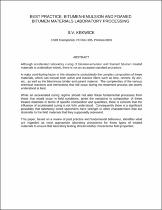 ResearchSpace
ResearchSpace
Best practice: bitumen-emulsion and foamed bitumen materials laboratory processing
JavaScript is disabled for your browser. Some features of this site may not work without it.
- ResearchSpace
- →
- Research Publications/Outputs
- →
- Conference Publications
- →
- View Item
| dc.contributor.author |
Kekwick, SV

|
|
| dc.date.accessioned | 2008-01-21T08:06:32Z | |
| dc.date.available | 2008-01-21T08:06:32Z | |
| dc.date.issued | 2005-07 | |
| dc.identifier.citation | Kekwick, SV. 2005. Best practice: bitumen-emulsion and foamed bitumen materials laboratory processing. SATC 2005: The 24th Annual Southern African Transport Conference and Exhibition, Pretoria, South Africa, 11-13 July, 2005, pp. 1-18 | en |
| dc.identifier.uri | http://hdl.handle.net/10204/1865 | |
| dc.description.abstract | Although accelerated laboratory curing of bitumen-emulsion and foamed bitumen treated materials is undertaken widely, there is not an accepted standard procedure. A major contributing factor to this situation is undoubtedly the complex composition of these materials, which can include both active and inactive fillers such as lime, cement, fly ash, etc., as well as the bituminous binder and parent material. The complexities of the various chemical reactions and interactions that will occur during the treatment process are poorly understood at best. While an accelerated curing regime should not alter these fundamental processes from those that would occur in field conditions, given the variations in composition of these treated materials in terms of specific composition and quantities, there is concern that the influence of accelerated curing is not fully understood. Consequently there is a significant possibility that laboratory cured specimens have strength or other characteristics that are dissimilar to the field materials that they supposedly represent. This paper, based on a review of past practice and fundamental behaviour, identifies what are regarded as most appropriate laboratory procedures for these types of treated materials to ensure that laboratory testing should reliably characterise field properties | en |
| dc.language.iso | en | en |
| dc.subject | Bitumen-emulsion | en |
| dc.subject | Anionic emulsion | en |
| dc.subject | Unconfined compression test | en |
| dc.subject | UCS | en |
| dc.subject | Indirect tensile strength | en |
| dc.subject | ITS | en |
| dc.title | Best practice: bitumen-emulsion and foamed bitumen materials laboratory processing | en |
| dc.type | Conference Presentation | en |
| dc.identifier.apacitation | Kekwick, S. (2005). Best practice: bitumen-emulsion and foamed bitumen materials laboratory processing. http://hdl.handle.net/10204/1865 | en_ZA |
| dc.identifier.chicagocitation | Kekwick, SV. "Best practice: bitumen-emulsion and foamed bitumen materials laboratory processing." (2005): http://hdl.handle.net/10204/1865 | en_ZA |
| dc.identifier.vancouvercitation | Kekwick S, Best practice: bitumen-emulsion and foamed bitumen materials laboratory processing; 2005. http://hdl.handle.net/10204/1865 . | en_ZA |
| dc.identifier.ris | TY - Conference Presentation AU - Kekwick, SV AB - Although accelerated laboratory curing of bitumen-emulsion and foamed bitumen treated materials is undertaken widely, there is not an accepted standard procedure. A major contributing factor to this situation is undoubtedly the complex composition of these materials, which can include both active and inactive fillers such as lime, cement, fly ash, etc., as well as the bituminous binder and parent material. The complexities of the various chemical reactions and interactions that will occur during the treatment process are poorly understood at best. While an accelerated curing regime should not alter these fundamental processes from those that would occur in field conditions, given the variations in composition of these treated materials in terms of specific composition and quantities, there is concern that the influence of accelerated curing is not fully understood. Consequently there is a significant possibility that laboratory cured specimens have strength or other characteristics that are dissimilar to the field materials that they supposedly represent. This paper, based on a review of past practice and fundamental behaviour, identifies what are regarded as most appropriate laboratory procedures for these types of treated materials to ensure that laboratory testing should reliably characterise field properties DA - 2005-07 DB - ResearchSpace DP - CSIR KW - Bitumen-emulsion KW - Anionic emulsion KW - Unconfined compression test KW - UCS KW - Indirect tensile strength KW - ITS LK - https://researchspace.csir.co.za PY - 2005 T1 - Best practice: bitumen-emulsion and foamed bitumen materials laboratory processing TI - Best practice: bitumen-emulsion and foamed bitumen materials laboratory processing UR - http://hdl.handle.net/10204/1865 ER - | en_ZA |





